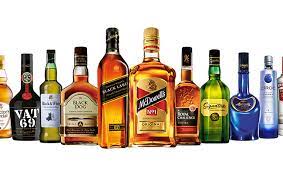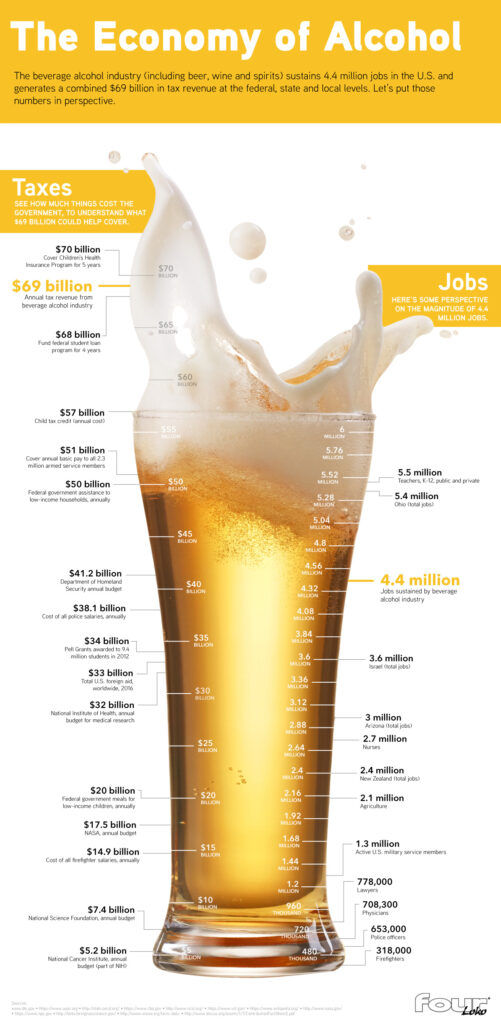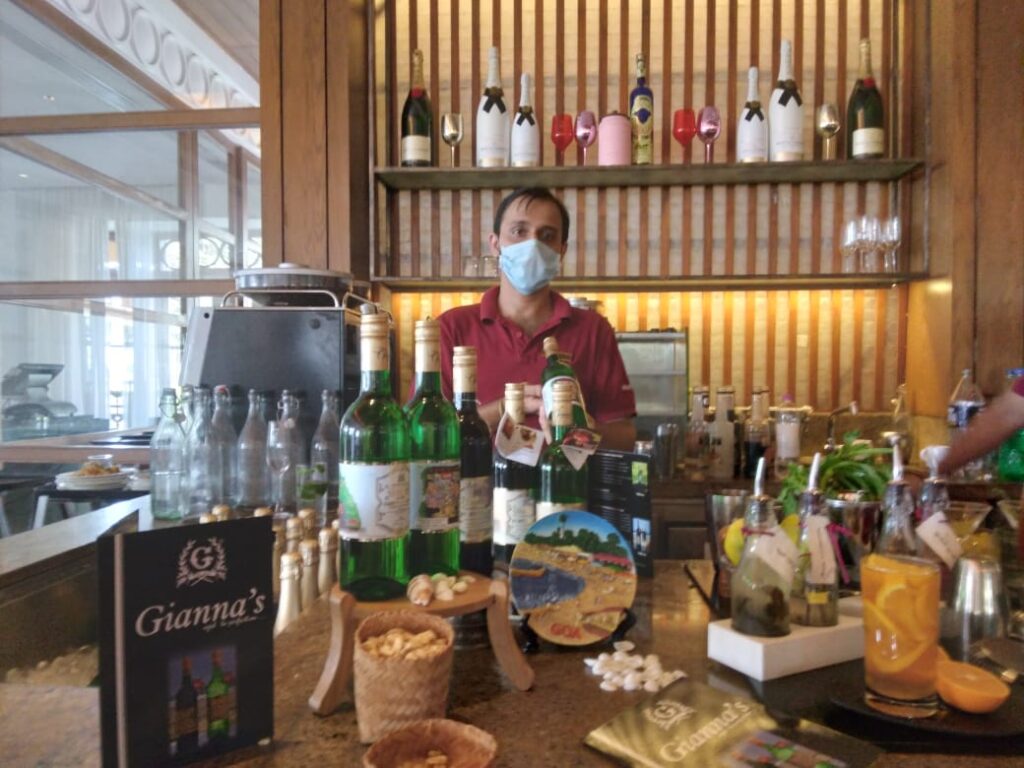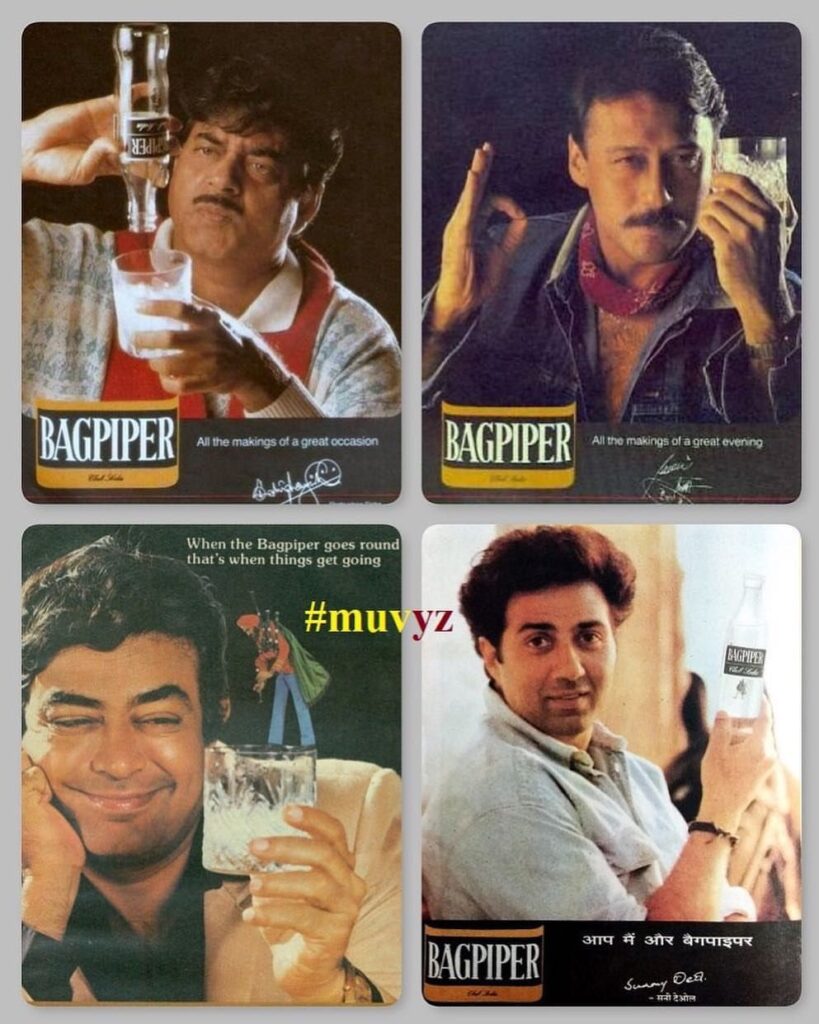How do drunkards of the world improve the economy awesomely each day?
The annual global average alcohol consumption is 6.4 liters per person older than 15 (in 2016). To account for the differences in alcohol content of different alcoholic drinks (e.g. beer, wine, spirits), this is reported in liters of pure alcohol per year.

Labels designed by the famous cartoonist Billytoons,Dubai
To make the 6.4 liter average more understandable we can express it in bottles of wine. Wine contains around 12% of pure alcohol per volume 2 so that one liter of wine contains 0.12 liters of pure alcohol. The global average of 6.4 liters of pure alcohol per person per year therefore equals 53 bottles of wine per person older than 15 (6.4l / 0.12l). Or to make it more memorable, around 1 liter of wine per week.

Alcoholic beverages ( FMCG Category) are widely consumed throughout the world. While most of the adult population drinks at low-risk levels most of the time or abstains altogether, the broad range of alcohol consumption patterns, from daily heavy drinking to occasional hazardous drinking, creates significant public health and safety problems in nearly all countries. This section examines global and regional alcohol consumption, abstinence from alcohol use and patterns of drinking. It also looks at the use of homemade or illegally produced alcoholic beverages, alcoholic beverage preference and recent trends in alcohol use. The main data source for information presented in this section is the WHO Global Information System on Alcohol and Health (GISAH).

Covid-19 may change many aspects of work, life and the economy, but India’s relationship with alcohol will likely remain intact. If anything, the linkages might get stronger.
Why all States demand Liquor Sales?
For nearly all state governments, liquor revenues are a cash cow. There are four states that collected above ₹20,000 crore in taxes from the sale of liquor in 2018-19: Tamil Nadu, Uttar Pradesh, Maharashtra and Telangana. This should be seen in the context of their own tax revenues (as opposed to what they received from the central government). As many as 21 states, including several large states, derived more than 15% of their own tax revenues from the sale of liquor.
Can’t ignore alcohol revenue in India.
For north-eastern states, which lead in terms of the share of male population drinking alcohol, the contribution of liquor taxes to the exchequer is even higher. For example, in 2018-19, about 58% of Mizoram’s own tax revenues came from liquor taxes. That figure for Meghalaya was about 47% .Even a 15% share of own tax revenues is a big deal for states. Around half the combined revenues of states come from taxes collected by the Centre that it shares with them. With India shifting to a system of ‘one nation, one tax’ in July 2017—the goods and services tax (GST)—the tax levers available to states have significantly reduced.
On day two of reopening, Karnataka reported single-day liquor sales of ₹197 crore, its largest ever. Similar record sales were seen in Uttar Pradesh and Delhi.
When the pandemic-induced lockdown was first announced, the Centre excluded liquor shops in the category of establishments that would stay open. It was not deemed to be “essential”. States backed the Centre’s stance. But as the days under the lockdown accumulated, and as the economy and tax collections slumped (with more money from the Centre not forthcoming), states started clamouring with the Centre to allow liquor vends to reopen.

Why were states keen to open liquor shops during the nation-wide lockdown?
State GST collection which is the primary source of revenue for the states has been abysmally low due to the stoppage of almost all economic activities during the lockdown. This revenue loss has hit them hard as it came at a time when they had to incur extra costs related to the prevention measures, treating COVID-19 patients and in providing support to the poor and vulnerable sections of society. One of the major sources of revenue for the states is the production and sale of liquor. A ban on alcohol sales was a crucial part of the lockdown, but it deprived states of critical revenue.
Market size
The alcohol market in India was valued at around ₹2,807,237 Bn in 2018 and is anticipated to reach nearly ₹5,482,851 Bn by the end of 2027, growing at a CAGR of 7.8% during the forecast period (2019 to 2027). The Indian alcohol market is expanding rapidly with wine and vodka showing very high demand. India also happens to be the largest consumer of whiskey in the world. The government data suggests that around 16 Crore people in India consume alcohol regularly. On an average, 594 million litres of liquor are sold in India every year, but by 2022, the consumption of alcohol is expected to increase to 1680 million litres. Between 2010 and 2017, the per capita alcohol consumption in India and total sale of alcoholic beverages increased by about 38%.
Data also suggests that though the share of Indians drinking is on the decline, the consumption per individual has increased. According to the World Health Organization (WHO), average alcohol consumption in India was 5.7 litres per person above the age of 15 per year in 2016, up from 4.3 litres in 2010. On per capita consumption, India is ranked 101 (with Moldova leading with 15.2 litres. In the immediate neighbourhood, the figure for Pakistan is 0.3 litres and China is 7.2 litres)

On The Rocks Or With KOMIN NATURE CRAFTED ALKALINE WATER.
The harmful use of alcohol is a worldwide problem resulting in millions of deaths, including hundreds of thousands of young lives lost. It is not only a causal factorin many diseases, but also a precursor to injury and violence.
Furthermore, itsnegative impacts can spread throughout a community or a country, and beyond, by influencing levels and patterns of alcohol consumption across borders.
Alcohol’s impact on the UK Economy: Benefits National Income
The alcohol industry is a small, but not insignificant, part of the UK economy, contributing £46 billion a year, around 2.5% of total GDP, to national income.

Brian Marchon Promoter/Director, Gianna’s Port Wine and Cashew Apple Feni Goa, Merchandising the product at “Barracuda Dubai”.
This income is split evenly between the production (e.g. brewers, distillers) and retail (e.g. pubs, bars, supermarkets) of alcohol. Brewing beer for the domestic market (especially the on-trade), and distilling spirits for export are particularly significant economic activities in the UK.
The UK alcohol market shrank by 5% in real terms between 2004 and 2014, with lower per capita consumption and the shift of sales from pubs, bars and clubs to supermarkets and off-licenses contributing equally to this trend. If there had been no shift in drinking from the on-trade to the off-trade, this would be worth £6 billion to the UK alcohol market, and would have prevented any decline in revenue.
Employment, Wages and Productivity.
We estimate that the alcohol industry is responsible for around 770,000 jobs, around 2.5% of all UK employment, the vast majority (506,000) of which are in pubs, clubs and bars. Such on-trade jobs are typically part-time and poorly paid: only a third of employees have full time positions, and their median wage of £6.82 is the second lowest of all occupations tracked by the Office for National Statistics. By contrast, alcohol producers provide relatively few jobs (fewer than 30,000), but these tend to be better paid, with average wages exceeding
£16 per hour.
These differences in wages reflect the fact that the manufacture of alcohol has higher productivity than its sale, as a result of the high mechanisation of breweries and distilleries. However, productivity appears to have fallen in both sectors since 2011.
Despite pub closures, employment has been relatively resilient: full-time jobs in pubs rose by 7% between 2009 and 2014, though there are fewer part-time positions, and employment in bars and clubs has fallen.
It is sometimes argued that the alcohol industry is a particularly important employer in poorer or rural areas with few alternative sources of jobs. However, there are only seven local authorities where the alcohol producers account for more than 1% of jobs, and we find no systematic relationship between an area’s prosperity and its dependence on alcohol industry employment.
Trade
The UK has a small surplus in alcohol trade of £1.7 billion, almost entirely attributable to the export of spirits. However, this accounts for just 2% of the country’s overall current account deficit.
Government Finances
The Government raises £11 billion in tax revenue from alcohol excise duty in England. A lack of reliable figures means it is difficult to compare this against the cost of alcohol to the taxpayer, which likely ranges between £8-12 billion.

How much does Liquor contribute to World and Indian economy?
Worldwide consumption in 2005 was equal to 6.13 litres of pure alcohol consumed per person aged 15 years or older. A large portion of this consumption – 28.6% or 1.76 litres per person – was homemade, illegally produced or sold outside normal government controls. However, despite widespread consumption, a higher percentage of people currently do not drink at all.
Lifetime abstention from alcohol means exemption from personal alcohol-attributable disease, injury and death. Because abstention is so prevalent in the world, any diminution in abstention trends could have a big impact on the global burden of disease caused by the harmful use of alcohol.
The pattern of drinking score, reflecting the frequency and circumstances of alcohol consumption and the proportion of people drinking alcohol to intoxication, is among the lowest, i.e. less risky, in western European countries, while it is the highest in the Russian Federation, and in some neighbouring countries. Risky patterns of drinking are also highly prevalent in Mexico and southern African countries.
Harmful alcohol consumption is risky both for the drinker and for other people. An intoxicated person can put people in harm’s way by involving them in traffic accidents or violent behaviour, or by negatively affecting co-workers, relatives, friends or strangers.
A survey in Australia found that two thirds of respondents were adversely affected by someone else’s drinking in the past year. Alcohol consumption also affects society at large. Death, disease and injury caused by alcohol consumption have socioeconomic impacts, including the medical costs borne by governments, and the financial and psychological burden to families. The hazardous and harmful use of alcohol also impacts on workers’
productivity.
Perhaps the biggest social impact is crime and violence related to alcohol
consumption, which create signifi cant costs for justice and law enforcement sectors.

The researchers’ findings reveal some worrying — also surprising — trends. They found that, while patterns of alcohol consumption have not changed much in high-income countries, low- and middle-income regions are seeing a staggering increase.
At the global level, the team found that the total volume of alcohol consumed per year increased by as much as 70% between 1990 and 2017, from 20,999 million liters per year to 35,676 million liters per year.
“Before 1990, most alcohol was consumed in high-income countries, with the highest use levels recorded in Europe. However, this pattern has changed substantially, with large reductions across Eastern Europe and vast increases in several middle-income countries, such as China, India, and Vietnam,” explains Manthey.
Moreover, he adds, “This trend is forecast to continue up to 2030, when Europe is no longer predicted to have the highest level of alcohol use.”
In Europe, alcohol consumption — among adults, per capita, per year — decreased by 12%, from 11.2 liters to 9.8 liters between 2010 and 2017. The same figure increased by 34% in Southeast Asian countries, from 3.5 liters to 4.7 liters.
Over the same time period, alcohol consumption saw a small increase, from 9.3 liters to 9.8 liters, in the United States, and from 7.1 liters to 7.4 liters in China, though it decreased in the United Kingdom, from 12.3 liters to 11.4 liters.

Contribution of alcohol in indian economy
State governments are becoming more and more dependent on alcohol revenue to pay their bills. The increasing consumption of alcohol will only fuel this dependence, says K.P.M. Basheer.
Sabko maloom hai main sharaabi nahin
Phir bhi koi pilaye to main kya karoon
How much revenue does the government get from alcohol?
The northern state of Uttar Pradesh made the highest estimated revenue from excise duty on alcohol at about 315 billion Indian rupees across India in financial year 2020. Karnataka ranked second that year, followed by Maharashtra. The excise duty in Uttar Pradesh was levied on manufacture and sale of liquor, in addition to a special duty that collects money for other purposes, including maintaining stray cattle. Some other states also imposed value added taxes.
As per the results of a large scale survey conducted across India in 2020, majority of older adults between 45 and 59 years old consumed alcohol in the country. Teenagers made up an alarming 35 percent, despite minimum drinking age varying across some states in the country.
Contribution of alcohol to gdp
China was the global leader in alcohol consumption by volume in 2018. The nation consumed 54.29 billion liters of alcohol, nearly double the United States, the second ranked country. This consumption translates to a market value of 285.9 billion U.S. dollars for China. The landscape changes entirely when sales are looked at on a per capita basis; China’s ranking plummets to 37 with the average person buying 40.42 liters of alcohol in the year. In comparison, consumers in the Czech Republic, ranked first, bought 164.08 liters during the year.
More specifically, alcohol consumption per capita is likely to increase from 5.9 liters of pure alcohol per year in 1990 to 7.6 liters in 2030.
By that point in time, the investigators add, about half of all adults around the world will consume alcohol, and 23% of adults will engage in binge drinking at least once every month.
And since alcohol is a known risk factor for numerous health problems, the global burden of disease will, most likely, also increase.

Gianna’s “Fish Feni (Wine) Fun” evening @ Grand Hyatt Bambolim Goa.
From casual social outings to celebratory events, alcohol is frequently part of our lives. While the culinary and cultural value of these drinks is commonly emphasized, the economic impact is often forgotten. Alcohol plays an enormous role in our economy. In the U.S. alone, the alcohol beverage industry is responsible for sustaining more than 4 million jobs and generating almost $70 billion in annual tax revenue. And that doesn’t scratch the surface of the economic benefits the alcohol industry provides to late night restaurants and pizza shops.
Make no mistake, these numbers are significant. The taxes derived from your happy-hour cocktail, fine wine, or tailgate beer generates a surplus of revenue for federal, state, and local governments. From there, the money can be applied toward various social service programs and public organizations that improve your quality of life. For example, tax revenue from alcoholic beverages could be applied toward research and development for science and medical issues, like those studied at the National Institute of Health (which has an annual budget of $32 billion).
Gianna’s cocktail evening with band “Archie’s” @ Grand Hyatt Bambolim Goa.
It takes nearly 4.4 million people collectively to satiate America’s collective thirst. That’s more jobs than active U.S. military service members (1.3 million), or the total number of firefighters, police officers, physicians, and lawyers combined (2.5 million) in the U.S. Per the Beer Institute, the beer industry alone supports 1.75 million jobs. From the farmers harvesting the barley in your beer, to the beer truck driver, to your local bartender, every aspect of your drink exists because of someone in the alcohol industry working hard behind the scenes.
The positive economic impact of alcohol is something you seldom consider when having a drink, but, given the facts, maybe it’s time we all raise a glass.
Sources:
www.bls.gov
http://stats.oecd.org/
https://www.cbo.gov
http://www.ncsl.org/
https://www.vcf.gov/
https://www.wikipedia.org/
http://www.nasa.gov/
https://www.nps.gov
http://beta.foreignassistance.gov/
http://www.wswa.org/facts-data
http://www.beerinstitute.org/

What impact does alcohol have on society?
The Effect of Lower Alcohol Consumption on the Economy.
Reducing the harm associated with alcohol is likely to involve lower consumption. For example, the World Health Organization has recommended per capita consumption as one of the key indicators of its target of a 10% reduction in the harmful use of alcohol.
Such a prospect might cause alarm on economic grounds. However, there is little reason to believe lower alcohol consumption would have a negative effect on the economy
– indeed, it may boost national income. Lower alcohol consumption may not have any economic impact, if people maintain their spending on alcohol by buying more expensive
drinks – as we have shown, recent falls in consumption would have had no impact on industry revenue if drinkers had not shifted from pubs to supermarkets.Yet even if spending on alcohol declines, spending on other goods is likely rise to compensate and so boost other industries – the net effect of this shift to the alcohol industry and gain to other sectors is ambiguous.
In the ‘long run’ (when productive capacity is the main constraint on the economy) lower alcohol consumption is likely to have a positive effect by boosting productivity and labour supply, by reducing absenteeism, presenteeism, unemployment and premature mortality.
In the ‘short run’ (when a shortage of demand is the main constraint on the economy), the effect is more uncertain and depends critically on what products are substituted for alcohol. Without a detailed and rigorous modelling exercise, this is impossible to discern with any confidence, though:
Modelling in the US suggests lower alcohol spending can raise employment.
The Office for National Statistics’ economic multiplier estimates suggest a 10%
decrease in alcohol spending could increase or decrease national income by at
most £1 billion.
How does alcohol help the economy?

“Based on our data, the WHO’s aim of reducing the harmful use of alcohol by 10% by 2025 will not be reached globally,” warns Manthey.
“Instead,” he goes on, “alcohol use will remain one of the leading risk factors for the burden of disease for the foreseeable future, and its impact will probably increase, relative to other risk factors. Implementation of effective alcohol policies is warranted, especially in rapidly developing countries with growing rates of alcohol use.”
“Economic growth seems to explain the global increase in alcohol use over the past few decades. For example, the economic transitions and increased wealth of several countries — in particular the transitions of China and India — were accompanied by increased alcohol use.”
“One For The Road”! may be too many. Drink sensibly Drink to live long…

World Wide Festive Trends Decoded What Indian festive consumers seek Generic keywords related to festival shopping such as sale, discount,
How can FMCG Companies improve salesman’s technique in order to sell more? Some FMCG Salesmen, buyers and sellers are more
Why undestand FMCG sales management? Sales management is the process of developing a sales force, coordinating sales operations and implementing








